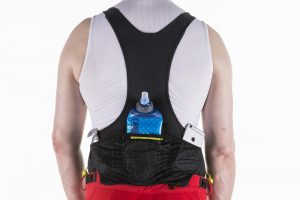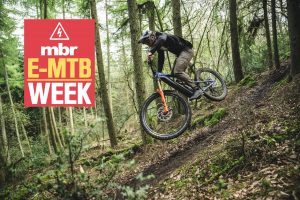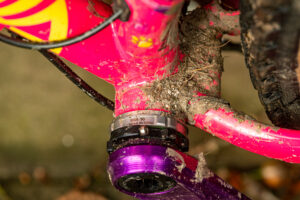Starling's new Roost hardtail is no ordinary clucker
Starling Roost hardtail first ride review
Is handmade really a feature? I suppose it is for an artisan baker and most definitely if you’re having a suit tailored to fit just so. But given that best high-performance mountain bikes, be they carbon, aluminium or steel, are all handmade, it’s not even worth mentioning on the spec sheet.

Built in Taiwan, at home in the UK’s sloppy ruts
What’s more important, at least for some, is where those hands are actually located. So while Joe McEwan from Starling Cycles makes some of his steel mountain bike frames right here in the UK, the Roost is manufactured in Taiwan by Ora.
That’s partly because one man can only produce so many frames by himself, so it makes sense to have helping hands overseas. Also Starling Cycles doesn’t have the expertise needed to work with stainless steel tubing, so that’s where Ora comes in.
So what is the Roost? In short it’s a sleek, fun, hardcore hardtail. The frame is crafted out of slender stainless steel tubing and the geometry has been designed around an MX wheel configuration – so you benefit from the additional roll over of a 29in wheel up front, combined with a stronger 27.5in wheel and shorter stays out back.

Rust-free naked finish
Starling Roost geometry
The front triangle of the Roost is clean, understated and conventional. For the frame finish the raw stainless tubing is shot peened, then brush-polished for that timeless look. No lacquer is needed as it won’t rust, so if you do scratch it you can buff it out with some stainless steel wool.
Starling offers three frame sizes, M to XL, where the size L sports a 470mm reach and the two sizes flanking it grow or shrink by 30mm. The welds are as neat as any I’ve seen and gussets on the underside of the top and down tube reinforce the head tube area.
Starling designs the geometry of the Roost around a 140mm travel fork, the RockShox Pike giving our test bike a relatively slack 63.5º headangle and a 75.2º seat angle with a saddle height of 740mm. Both measurements slightly slacker than claimed.

Starling has given the Roost a slack head angle and suggests a 140mm travel fork
It’s the rear triangle of the Roost that really defines its character. Not only does it have a smaller 27.5in rear wheel, it also has size specific chainstay lengths – 430mm on the L, 425mm on the M and 435mm on the XL. It’s something we’ve been requesting for years, as it helps maintain the same weight distribution across the entire size range. It’s rapidly becoming commonplace on full suspension bikes, so it’s great to see manufacturers like Nukeproof and Starling moving things forward in the hardtail arena too.

Innovative chainstay yoke gives loads of clearance but raises a right racket
Borrowing tech from its full suspension designs, Starling has added a tubular chainstay yoke that’s elevated from the BB shell. Not only does it look cool, it offers stacks of tyre clearance. How much is stacks? Well, with the 2.4in Michelin Wild AM tyre fitted, I had a full finger width of clearance either side of the stays and could put two fingers between the tread and the back of the tubular yoke. That’s more than enough to take a 2.8in tyre and still have room to spare.
Unfortunately the tubular yoke also elevates the stays, so the Roost suffers from more chain slap than other hardtails I’ve tested. Which is why I suggest doubling up on the chainstay protection.

Screw-through axle accommodates Boost hub… and 142mm hubs if you tighten it down
Cable routing on the Roost is all external and the frame has an international standard disc mount that’s designed to take up to a 200mm rotor with the appropriate adapter. The ultra neat dropouts make slotting the rear wheel in a breeze, just remember to undo the fixing bolt on the drive side before unwinding the 12mm rear axle. Starling adds the fixing bolt for additional security as there’s not as much thread on the thinner steel dropout. Starling also says that the frame is compatible with 148mm and 142mm hubs.
The frame is designed around the 148x12mm standard but Starling reckons there’s enough flex in the rear stays to tighten the axle down to take a 142mm hub. Yes, that sounds like a bit of bodge on a £1,220 frame, but most riders will run a standard 148mm boost hub so it’s not a big deal.

The Roost is a head turner in its polished raw finish
How it rides
The Roost had been pretty thoroughly roosted before I got my grubby mitts on it. As such, the 11-speed Shimano SLX gears weren’t the slickest. That wasn’t enough to stop me getting to grips with the bike though. On the first few outings, I played around with the fork pressure and handlebar height to dial in the riding position and weight distribution. With one 5mm spacer below the stem and 80psi in the RockShox Pike fork the bike felt really balanced.
Luckily this set-up leaves just enough clearance to prevent the shifter pod smashing into the top tube if the handlebar was to spin around in a crash.

A steeper seat tube would help climbing ability
While that riding position was great for descending and general singletrack shredding, I found that I had to pull myself forward on the bike when climbing, and that was with the saddle shoved all of the way forward on the head of the seat post.
There are two ways that Starling could remedy this. It could make the chainstays slightly longer, but that would rob some of the fun factor and defeat the purpose of the smaller 27.5in rear wheel. So a better solution would be to steepen the seat angle by a degree or so. Not so steep as to lose some of the flex in the seat tube, but enough to allow me to move the saddle forward a touch while keeping it more centred on the head of the post. Not only would this offer a more comfortable riding position for climbing, but it would also reduce the risk of the saddle rails bending.
Actually, there’s a third way. Dropping a 130mm spring assembly into the RockShox Pike fork would steepen things up a little and probably achieve Starlings intended geometry.

Compliance on the Starling was sterling, but Cushcore inserts definitely played a part in that
Still, with the dropper post slammed and gravity aiding progress rather than impeding it, the seated riding position on the Roost is the furthest thing from your mind. With Cushcore fitted front and rear the Roost offers more stability and compliance than expected. And while the insert is probably unnecessary in the front tyre, with only 40mm of tyre suspension on the rear, Cushcore makes a lot of sense as you can run lower tyre pressures without destroying the rim.
How much of the Roost’s ride quality is down to the tyre/inset combo or the frame material is hard to say, but you do notice the reduced acceleration and increased rolling resistance of the heavier wheels and tyres especially when accelerating or simply bowling along the blacktop. So while I’m convinced that fitting a 2.6in or even a 2.8in rear tyre would increase traction and comfort further, while reducing rolling resistance, it probably wouldn’t be the best choice of anyone wanting the steep up, steep down riding style the Roost is clearly designed for.
- Best hardtail mountain bikes
- Best mountain bikes: ultimate trail, enduro and cross-country bikes
- Best bodyweight exercises for mountain bikers
















